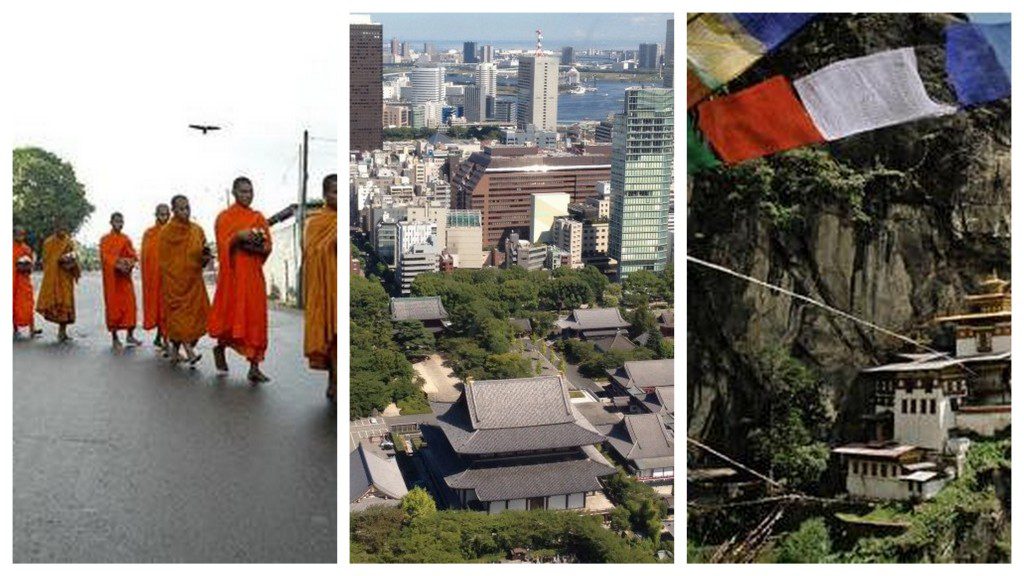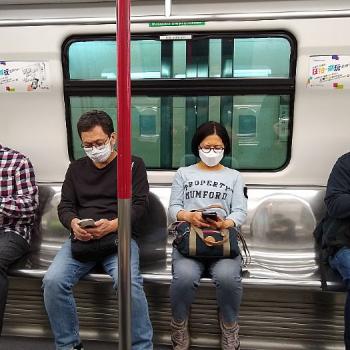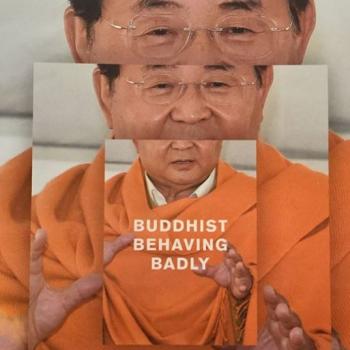 Sri Lanka, Japan, and (often most of all) Bhutan often elicit images of peaceful monks in flowing robes walking peacefully by. In Sri Lanka they go on orderly alms-rounds in villages, In Japan their temples are often sanctuaries in the midst of the chaos of an advanced industrialized economy, and in Bhutan the scene behind the monk is often a towering mountain, blue skies, and prayer flags releasing merit into the breeze.
Sri Lanka, Japan, and (often most of all) Bhutan often elicit images of peaceful monks in flowing robes walking peacefully by. In Sri Lanka they go on orderly alms-rounds in villages, In Japan their temples are often sanctuaries in the midst of the chaos of an advanced industrialized economy, and in Bhutan the scene behind the monk is often a towering mountain, blue skies, and prayer flags releasing merit into the breeze.
However many wonderful images may be conjured up at the mention of Buddhism in each country, the religion also has its problems in each. Or we could say ‘people of the religion’ if we want…
The BBC reports today “Sri Lanka crowd attacks Muslim warehouse in Colombo” –
(Five or six people were injured including a cameraman who needed stitches)Several people have been injured in Sri Lanka’s capital, Colombo, when Buddhist monks led hundreds in an assault on a Muslim-owned clothing warehouse.
Buddhist monks were filmed throwing stones at the storage centre of popular garment chain Fashion Bug in a suburb of the capital on Thursday night.
Of course this is only one in a long history of conflicts between Sinhala Buddhists and their Muslim and Hindu neighbors and countrymen. In 1956 the Ven. Walpola Rahula said:
“Under the influence of the new religion the Sinhalese worked in peace and harmony, and the country became prosperous. But soon there came adventurers from South India who disturbed the peace and progress of the island. One such was Elara, a Chola prince, who invaded Ceylon about the middle of the second century B.C., captured the government at Anuradhapura, and ruled for about forty-five years.””Though the northern part of the island was under a foreign rule, Rohana remained independent. This long period of foreign rule gave rise to several important developments, both national and religious, eg the history of the island. Duttha Gamani …. undoubtedly the greatest national hero of early Buddhist Ceylon, organized a great crusade to liberate Buddhism from foreign rule. His war-cry was “Not for kingdom, but for Buddhism.” The entire Sinhalese race was united under the banner of young Gamani. This was the beginning of nationalism among the Sinhalese…”(Walpola Rahula, History of Buddhism in Ceylon: The Anuradhapura Period, Colombo, M.D. Gunasena & Co. 1956, p. 79)
Writing for the Washington DC think-tank, the East-West Center, Neil DeVotta states (.pdf):
…nineteenth and twentieth century Buddhist nationalists deftly used the Durhagamani myth to institute Sinhalese Buddhist domination. According to Walpola Rahula, “The entire Sinhalese race was united under the banner of the young Gamini [i.e., Duthagamani]. This was the beginning of nationalism among the Sinhalese. . . . A non-Buddhist was not regarded as a human being. Evidently all Sinhalese without exception were Buddhists” (Rahula 1956: 79). Rahula is no doubt influenced by the Durhagamani myth in dehumanizing non-Buddhists. [emphasis mine]
If you have the time, you can see the outcome of this dehumanization here, at Channel 4’s Peabody award winning documentary, “Sri Lanka’s Killing Fields.”
Meanwhile in Bhutan, the land of Gross National Happiness is also the land of high stress, hypertension, obesity, and increasing prevalance of STDs, including HIV – and that’s just among the monastics (via Huffington Post):
Warning signs of risky behavior among monks first appeared in 2009, when a report on risks and vulnerabilities of adolescents revealed that monks were engaging in “thigh sex” (in which a man uses another man’s clenched thighs for intercourse), according to the state-owned Kuensel daily.
The health ministry got concerned when a dozen monks — including a 12-year-old — were diagnosed with sexual transmitted diseases a year later, Kuensel reports. At least five monks are known to be HIV-positive, the youngest being 19.
The 2012 report of the U.N. agency focused on AIDS response and progress also noted cases of HIV among Bhutan’s monks.
Bhutan’s Commission for the Monastic Affairs says stricter discipline is a solution. While corporal punishment is banned, monks told Kuensel it is still practiced.
So while the man in charge says stricter discipline is needed, including – apparently – corporal punishment, the story goes on to say that:
Psychiatrists suggest the spread of disease could be a result of mental stress. It is not uncommon for monks and nuns, mostly between the ages of 15 and 25, to visit psychiatrists. Even senior monks show symptoms of severe stress, especially when they are undergoing long periods of meditation, Dr. Damber Kumar Nirola told Kuensel.
“About 70 to 80 percent of (senior) monks are obese, hypertensive and also suffer from back ache because of their sitting posture and sedentary lifestyle,” urologist Lotay Tshering told the paper.
And not to leave the East Asian Buddhists out, we go to Tokyo, Japan. This time with a story from Yahoo News:
Japanese Buddhist monk Yoshinobu Fujioka enjoys bringing his congregation together, one cocktail at a time.
Fujioka owns the 23-seat “Vowz Bar” in central Tokyo, where Buddhist chants replace karaoke songs and the shaven-headed bartenders serve up sermons and homilies along with the drinks.
…
Vowz Bar has been going strong for 13 years and the cocktail list includes the vodka and cognac-based “Perfect Bliss” as well as “Infinite Hell” – a vodka, raspberry liqueur and cranberry juice concoction with a splash of tonic water.
The special is called “Enslavery to Love and Lust” and costs around 800 yen (5.59 pounds).
“Every day, my heart gets tainted by dirt in the secular world, so I come here to repurify it over some drinks and fun,” said regular patron Noriko Urai, a 42-year-old businesswoman.
I suppose all of this news may do us a service insofar as it disabuses any notions that there is some ‘pure’ ‘holy’ and fully upright Buddhism out there. Even with all of the scandal, cult-behavior, and so on that we can find in American Buddhism, we can rest assured that it’s not unique to American Buddhism, and hey, it’s not a “modern” thing either. Also, don’t worry, Thailand, Burma, Vietnam, and others all have similar – but uniquely their own – issues.
Now, where can I find a glass of “Enslavery to Love and Lust” in the UK?
(PS. small aside, but these are often the same people, with echoing voices in the West, who get so upset about Buddha images on bikinis or tatoos of the Buddha, “oh, that’s so offensive!” – But spreading disease, getting people drunk, and committing war crimes in the name of the Buddha-Dharma, that’s ok? As it is Good Friday, perhaps we can take a note from a nice Palestinian Jewish rabble-rouser from around 2000 years ago:
“Judge not, that you be not judged. For with what judgment you judge, you will be judged; and with the measure you use, it will be measured back to you. And why do you look at the speck in your brother’s eye, but do not consider the plank in your own eye? Or how can you say to your brother, ‘Let me remove the speck from your eye’; and look, a plank is in your own eye? Hypocrite! First remove the plank from your own eye, and then you will see clearly to remove the speck from your brother’s eye.”
Matthew 7:1-5)











